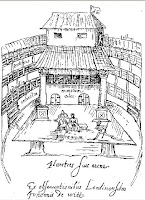 I’ve been doing lots of reading/research lately for my new projects, a new full-length novel and an “Undone” short story to go with it set in the Elizabethan theater scene! (Alas, they’re both still untitled…) In my reading I noticed that on this day in 1613 the first Globe Theater burned down (this won’t be happening to my fictional theater in the book!). So I thought I would share a bit of my notes for this Tuesday post.
I’ve been doing lots of reading/research lately for my new projects, a new full-length novel and an “Undone” short story to go with it set in the Elizabethan theater scene! (Alas, they’re both still untitled…) In my reading I noticed that on this day in 1613 the first Globe Theater burned down (this won’t be happening to my fictional theater in the book!). So I thought I would share a bit of my notes for this Tuesday post.
Old property records and the discovery of some of the archaeological remains indicate the Globe was sites from the west side of modern Southwark Bridge, east as far as Porter Street and from Park Street south to the back of Gatehouse Square. (Its site was only speculation until part of the foundation, including one original pier base, was found under the Anchor Terrace car park on Park Street in 1989. The materials and some of the shape could be analyzed and preserved, but since most of the foundation lies under another listed building it couldn’t be further excavated).
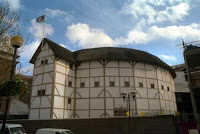 The Globe was the playing house of the Lord Chamberlain’s Men, a troupe owned by actors/shareholders. The main shareholders, brothers Richard and Cuthbert Burbage, owned 25% apiece with four actors owning 12.5% each (Shakespeare, John Heminges, Augustine Phillips , and Thomas Pope. Originally the comedian Will Kempe was intended to be the 7th partner, but he left and sold out his shares to the 4 minority holders. New sharers were added over time). It was built in 1599 using the materials from The Theatre in Shoreditch, built in 1576 by the Burbages’ father James on land which originally had a 21-year lease (but the building he owned outright). But the dastardly landlord, Giles Allen, claimed the building became his on the expiration of the lease, leading to a protracted legal battle. Thus on December 28, 1598, while Allen was out of town for Christmas, the actors dismantled The Theatre and transported it to a warehouse near Bridewell. With the arrival of warmer spring weather, the pieces were ferried over the Thames and reconstructed as The Globe on some marshy garden plots south of Maiden Lane in Southwark!
The Globe was the playing house of the Lord Chamberlain’s Men, a troupe owned by actors/shareholders. The main shareholders, brothers Richard and Cuthbert Burbage, owned 25% apiece with four actors owning 12.5% each (Shakespeare, John Heminges, Augustine Phillips , and Thomas Pope. Originally the comedian Will Kempe was intended to be the 7th partner, but he left and sold out his shares to the 4 minority holders. New sharers were added over time). It was built in 1599 using the materials from The Theatre in Shoreditch, built in 1576 by the Burbages’ father James on land which originally had a 21-year lease (but the building he owned outright). But the dastardly landlord, Giles Allen, claimed the building became his on the expiration of the lease, leading to a protracted legal battle. Thus on December 28, 1598, while Allen was out of town for Christmas, the actors dismantled The Theatre and transported it to a warehouse near Bridewell. With the arrival of warmer spring weather, the pieces were ferried over the Thames and reconstructed as The Globe on some marshy garden plots south of Maiden Lane in Southwark!
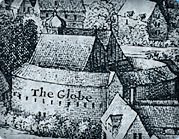 The Globe’s actual dimensions are unknown, but evidence suggests it was a 3-story, open-air space about 100 feet in diameter that could fit in about 3000 spectators. In a famous sketch of the period done by Wenceslas Hollar it’s shown as round, but the excavations show it was actually a polygon of 20 sides. At the base of the stage is the pit, or yard, where for a penny the groundlings would stand on the dirt, rush-covered floor to watch the play (and eat and drink and fight). Around the yard rose 3 levels of stadium-style seating, each level more expensive (audience members would pay at the door of their chosen level). There were also private boxes for very wealthy people.
The Globe’s actual dimensions are unknown, but evidence suggests it was a 3-story, open-air space about 100 feet in diameter that could fit in about 3000 spectators. In a famous sketch of the period done by Wenceslas Hollar it’s shown as round, but the excavations show it was actually a polygon of 20 sides. At the base of the stage is the pit, or yard, where for a penny the groundlings would stand on the dirt, rush-covered floor to watch the play (and eat and drink and fight). Around the yard rose 3 levels of stadium-style seating, each level more expensive (audience members would pay at the door of their chosen level). There were also private boxes for very wealthy people.
The stage, an apron-style thrust stage, went out into the middle of the yard and was about 43 feet wide, 27 feet deep, and raised about 5 feet from the ground. In the middle was a trap door for ghosts and such to enter the scene. Large, faux-marble painted columns on either side supported the roof over the rear of the stage (the ceiling of this was called the “heavens” and was painted to resemble the sky. There was another trap door here where actors could be lowered using a harness–literally a deus ex machina!). The back wall had two or maybe three doors at the main level, with a curtained inner stage in the center and a balcony above. These doors went into the tiring house, a sort of green room where costumes could be changed and actors waited for the cues. Musicians used the balcony and it could also be used as scenery (like the balcony scene of Romeo and Juliet).
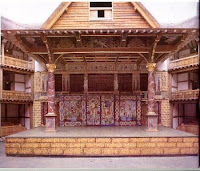 This Globe had a glorious run, seeing the premiere of most of Shakespeare’s great plays as well as hundreds of works now lost (or at least more obscure!). But on June 29, 1613 the thatched roof was set on fire by a cannon fired in a performance of the play Henry VIII and the Globe burned to the ground (though no lives were lost!). By then Shakspeare was mostly in retirement in his fine new house in Stratford, and would die 3 years later. The Globe was built again in 1614, with a tile roof replacing the thatch. In 1642 the new Puritan government closed down all the country’s theaters and the Globe was pulled down to make way for tenements. It came back to life in 1997, about 750 feet from the original on the banks of Thames.
This Globe had a glorious run, seeing the premiere of most of Shakespeare’s great plays as well as hundreds of works now lost (or at least more obscure!). But on June 29, 1613 the thatched roof was set on fire by a cannon fired in a performance of the play Henry VIII and the Globe burned to the ground (though no lives were lost!). By then Shakspeare was mostly in retirement in his fine new house in Stratford, and would die 3 years later. The Globe was built again in 1614, with a tile roof replacing the thatch. In 1642 the new Puritan government closed down all the country’s theaters and the Globe was pulled down to make way for tenements. It came back to life in 1997, about 750 feet from the original on the banks of Thames.
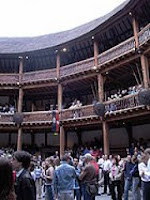 In my book, the heroine’s father is an entrepreneur theater owner (much like James Burbage or Philip Henslowe) and the hero is an actor/playwright/troublemaker/spy, so I’ve been having a wonderful time reading about the bawdy, wild, genius world of the Elizabethan theater! Originally I had the idea on my trip to London a couple years ago, when I got to attend A Midsummer Night’s Dream at the new Globe. I knew I would have fun there, but I didn’t expect how magical it all would feel! If I ignored the modern dress of the audience, and the fact that really they were all very polite (no throwing of anything on stage or stuff like that!) I could almost imagine being transported back to the 1590s. It’s a very different feeling from modern theater-going, it seemed more intimate, as if the audience was part of the action onstage. And the actor playing Lysander was very dishy. :))
In my book, the heroine’s father is an entrepreneur theater owner (much like James Burbage or Philip Henslowe) and the hero is an actor/playwright/troublemaker/spy, so I’ve been having a wonderful time reading about the bawdy, wild, genius world of the Elizabethan theater! Originally I had the idea on my trip to London a couple years ago, when I got to attend A Midsummer Night’s Dream at the new Globe. I knew I would have fun there, but I didn’t expect how magical it all would feel! If I ignored the modern dress of the audience, and the fact that really they were all very polite (no throwing of anything on stage or stuff like that!) I could almost imagine being transported back to the 1590s. It’s a very different feeling from modern theater-going, it seemed more intimate, as if the audience was part of the action onstage. And the actor playing Lysander was very dishy. :))
Here are a few books I’ve been using as I get into the story:
JR Mulryne and Margaret Shewring, Shakespeare’s Globe Rebuilt (1997: lots of great, in-depth info about the evidence of the original Globe and how it was used and adapted for modern requirements in the new Globe)
Julian Bowsher and Pat Miller, The Rose and the Globe–Playhouses of Shakespeare’s Bankside, Southwark (2010–a brand new publication from the Museum of London which someone kindly sent me, it’s great)
James Shapiro, 1599: A Year in the Life of William Shakespeare (2005)
Thomas Dekker, The Gull’s Hornbook (1609, reprinted in 1907–a fabulous source for the very colorful life of the Elizabethan underworld!)
Andrew Gurr, The Shakespearean Stage 1574–1642 (1991) and Playgoing in Shakespeare’s London (1987)
RA Foakes and RT Rickert, eds, Philip Henslowe’s Diary (1961–a must-read for anyone interested in the theater of this period)
Richard Dutton, Mastering the Revels: The Regulation and Censorship of English Renaissance Drama (1991)
The Cambridge Companion to English Renaissance Drama (1990)
Park Honan, Christopher Marlowe, Poet and Spy (2005)
The Globe website
Shakespeare Resource Center
The Old Globe Theater History
What’s your favorite theater-going memory? Any favorite plays (Shakespeare or otherwise!)??

I’ve only ever seen one Shakespeare play ‘live’ and that was Hamlet, set in a mental ward with long john underwear (don’t ask!) I wish people would stop doing experimental versions of things and just let ordinary folk like myself see what a real Shakespearian performance would have been like!
As I know I’ve mentioned here before, I saw Ian McKellen doing a one-man show of Shakespeare soliloquies, maybe 25 years ago. It was incredible.
When I was in London several years ago I bought cheap seats to see My One and Only with friends of mine. we got to the theatre and found out the balcony was closed. We were disappointed until the usher told us they upgraded our seats to the second row. We were really excited until about five minutes before the musical the usher handed us a poncha with a note saying “Please put this on during intermission.” I put mine on and my friends did not. Turns out the second act opens with a scene where the characters tap dance in water and we got soaked. It was fun.
“I wish people would stop doing experimental versions of things and just let ordinary folk like myself see what a real Shakespearian performance would have been like”
LOL Alison! I agree. I’m sort of stodgy when it comes to Shakespeare and opera performances–I like traditional, period productions the best (usually). I think this is because often it doesn’t make sense–the directors just think “Oh, we’ve done “Taming of the Shrew” in Renaissance dress a million times, let’s just set it in New Orleans in the 1950s ’cause the costumes would look great”! Sometimes it can be great though, like the Ian McKellen film of Richard III set in a fascist 1930s or the “Shakespeare RETOld” films (which use the stories but not all the language). These can show the timelessness of the play’s themes, but they have to make sense in that context…
LOL, Jane Austen! I love that story. Aren’t you glad you wore that poncho? 🙂
Megan, I am very jealous you got to see Ian McKellen in person! It must have been so amazing
My favorite theater-going experience?
I remember as maybe a 5th grader going to a performance of The Boyfriend in one of Arlington VA’s parks and being entralled with it.
More recently, attending The Phantom of the Opera on Broadway was pretty great. We got to go backstage because I learned serendipitously that the sister of a high school classmate (from Alabama) was in the cast. She took us on a backstage tour.
I am such a Shakespeare junkie! I’ve managed to see all his plays and read most of them, and act in five of them… Amanda, I totally agree with your balanced statement that sometimes a weird Shakespeare works, but usually it doesn’t! My thoughts exactly.
My fave Shakespeares, BTW, are (in no particular order) Twelfth Night, Much Ado, Hamlet, Macbeth, Lear, and Richard II. FWIW!
Cara
I went to the Globe the first year that it was open and loved it. I stood in the pit, and it really gave me a feeling of what it must have been like back then. I saw Henry V starring the artistic director Mark Rylance. I went back a few years later and saw Vanessa Redgrave play the weirdest Prospero in The Tempest. One of my favorite films will always be Shakespeare in Love. I don’t know if they still do it, but if you bought your ticket just before the curtain, they charged you the same price they did back in the 16th century.
I certainly agree about willy-nilly updates of Shakespeare, but I’ve seen several that worked. For some reason “Much Ado About Nothing” seems to be a favorite for updating. Years ago Sam Waterston played Benedict in a version that had been updated to early 19th C America; the soldiers had been Rough Riders with Teddy Roosevelt. Another update moved it to 1950s New York; the Prince of the City was the Police Chief. For whatever reason, perhaps because the director and actors respected the language, the updates added resonance and did not distract.
As for modern plays, my favorite is Tom Stoppard’s “Arcadia”. It’s a fitting play for the Riskies, as half of it takes place in Regency England.
Amanda, they’re excavating the “real” Globe site in Shoreditch this summer and it’s possible to get tours, something I’m considering when I take a quick trip to London for the RNA conference next week (aargh! So soon!). http://tinyurl.com/26xwhb8
Best theater? The final performance of Peter Brooks’ Midsummer Nights Dream by the RSC in uh, 1970 (I was quite young). Lots of RSC and Old Vic stuff. I was very lucky to be in London at that time.
Like Elizabeth, I got to go to the replica Globe the year it debuted. My then-boyfriend, now-husband and I were groundlings at a performance of The Merchant of Venice, and it was the best cheap date I’ve ever had.
Diane, you should blog about the backstage visit sometime! I would love to hear more about it. 🙂
Elizabeth, I also LOVE “Shakespeare in Love”–it’s not only romantic and gorgeous-looking, but there’s tons of funny little jokes (like the “souvenir of Stratford” mug on his desk, etc). I wasn’t a groundling when I went to the Globe (I think I’m too old to stand that long now!) but rented a cushion and sat on the first row of the top tier, so I could watch the audience as well as the play. 🙂
Janet, I’ve read so much about that legendary “Dream” production and want to hear more about it!!! (I missed it by not being born yet, and it sounds really—magical)
(I missed it by not being born yet, and it sounds really—magical)
AAAARGH!
Yes, it was magical. It was a messing around with Shakespeare that worked.
Putting attending a Shakespeare play at the Globe in London on my “bucket list.” There is so much on the list I have decided I am never going to die because it will take and eternity get everything on that list done!
I saw Patrick Stewart in a performance of Macbeth at the Shakespeare theatre in Stratford on Avon when I was in junior high. He was PHENOMENAL !!
A replica of the Globe is used in Cedar City, Utah, for the Shakespearian festival held there in August and October. I enjoy his comedies, not his tragedies.
My earliest theatre memory was when I was in elementary school, and the family went to see a college production of “Charley’s Aunt.” My favorite line was “I’m Charley’s Nut from Brazil, where the Aunts come from.” Years later, I saw a London production on PBS. I was so disappointed to learn that line isn’t in the original script! My favorite all time play is Les Mis. I was blessed to see it on the London stage, with the original cast, before it came to the U.S. I endeavored to see it every time it came to the Valley.
Oooh!! Louisa! Patrick Stewart! I’m trying so hard not to be jealous!!
Louisa, I’m also trying not to be jealous. 🙂 I recently watched the PBS broadcast of the “Hamlet” starring him and David Tennant, it was totally spellbinding. And a trip to the Globe is a great entry to a bucket list. (They’re doing a new play this summer, “Anne Boleyn,” I would LOVE to see!)